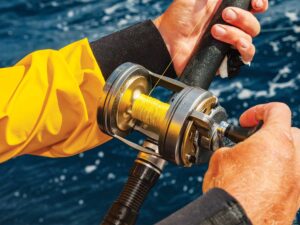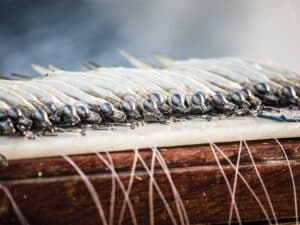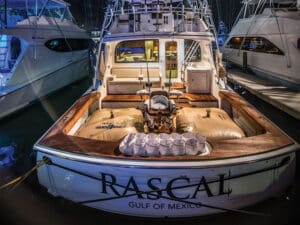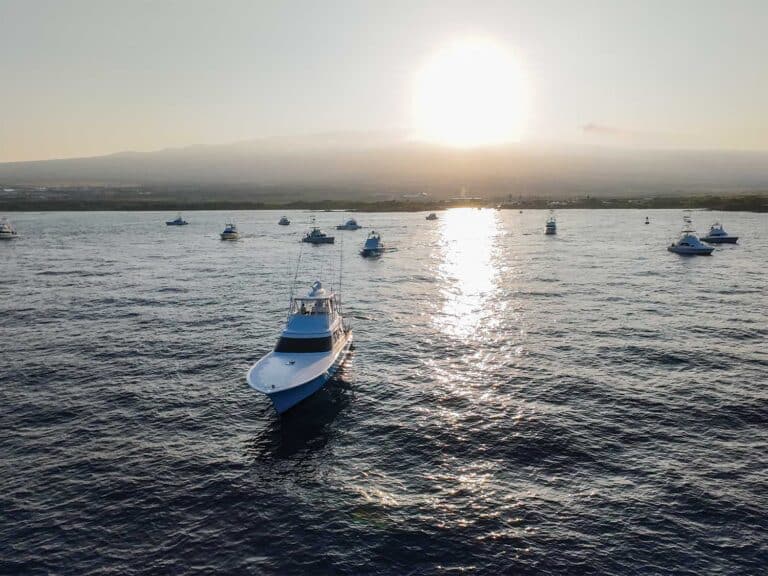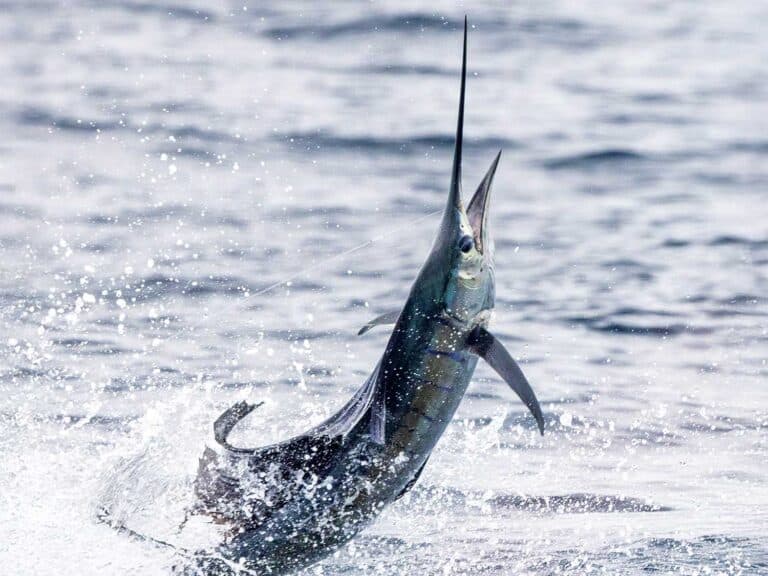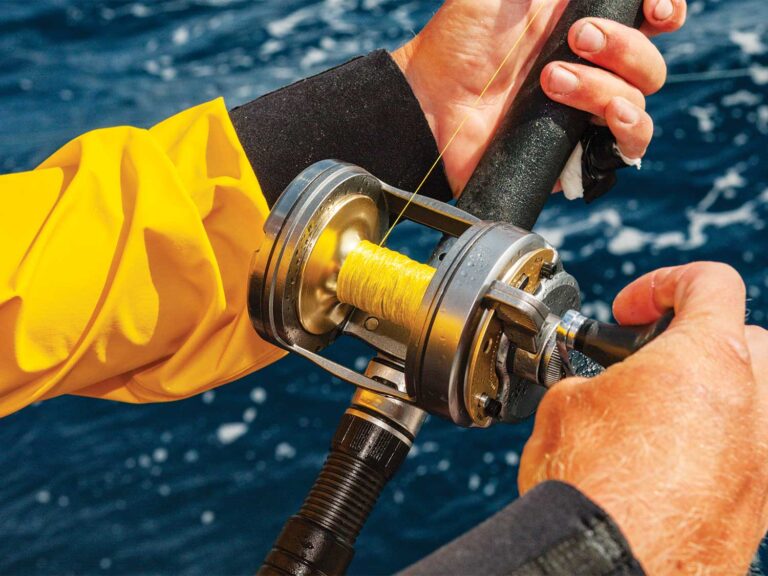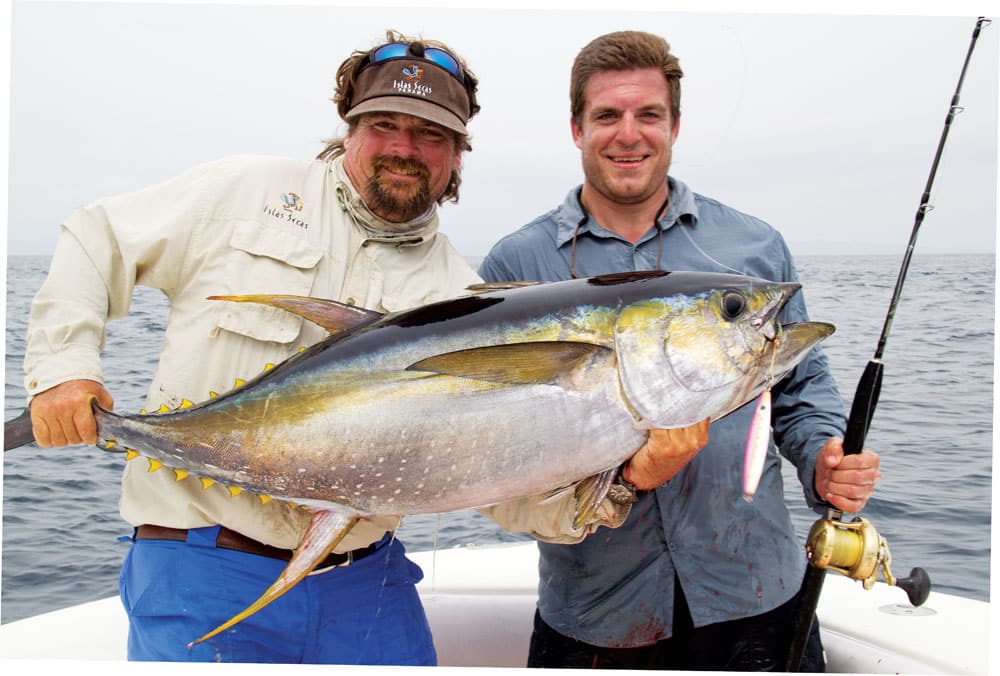
Trolling live skipjacks for black marlin on Panama’s Hannibal Bank turned out to be a little too slow for Lorton Mitchell, a West Coast angler from San Diego, California, so he decided to move up to the bow of the 31-foot Carolina, spinning rod in hand, and look for some action. Plenty of spinner dolphin cruised nearby, and the terns sporadically dipping on the surface signaled the presence of yellowfin tuna. Mitchell was a newcomer to Panama, as well as to using a spinning outfit for pelagic fishing.
After several blind casts, Mitchell put the new Shimano Orca lure on a “nervous” patch of ocean being worked by the terns. A big yellowfin tuna leaped three feet out of the water to inhale the lure and burned 40 pounds of drag off the reel on a long surface run. Making his way back to the cockpit, Mitchell was speechless for a minute. “Did you see that fish jump on my lure?” he asked at last. “Amazing. I’ll never forget that!” He then settled into a 1-hour-and-35-minute struggle in the hot, tropical sun.
When the fish finally came to the gaff, we could see that the tuna had engulfed the lure. The complete package of a Shimano Saragosa 18000F reel with 80-pound PowerPro Super 8 Slick Spectra and an Ocean Tackle International (OTI) OceanXtreme rod did its job. On the dock at the Panama Big Game Fishing Club, the digital scale topped out at 168 pounds.
Many yellowfin weighing more than 200 pounds are being caught worldwide with new specialized light tackle designed for popping and jigging for pelagics, as well as big inshore fish. This is the fastest-growing aspect of today’s sport fishing, and it’s not just for the small-boat fleet; large yachts and long-range sport-fishing fleets are adding both spinning and conventional tackle that are tough enough to handle heavy drags and heavy game fish.
Kil Song of JigNPop Tackle in New Jersey just returned from a long-range tuna trip in San Diego, where the crews have historically been snobby about light tackle, and spinning in particular. “It was a great experience,” Song says. “Excel was evenly divided between the traditional live-bait guys and my group. We didn’t interfere with each other, because the live-baiters drifted into the wind and we cast downwind. Our fishing style was productive, with yellowfin up to 216 pounds, even though the fish were deep and not showing well off the Tres Marias Islands on Mexico’s mainland. It showed that we belong on the long-range boats.” Not one to waste time, Song then departed for French Polynesia in pursuit of dogtooth tuna and giant trevally — Hatteras bluefin are next on the list.
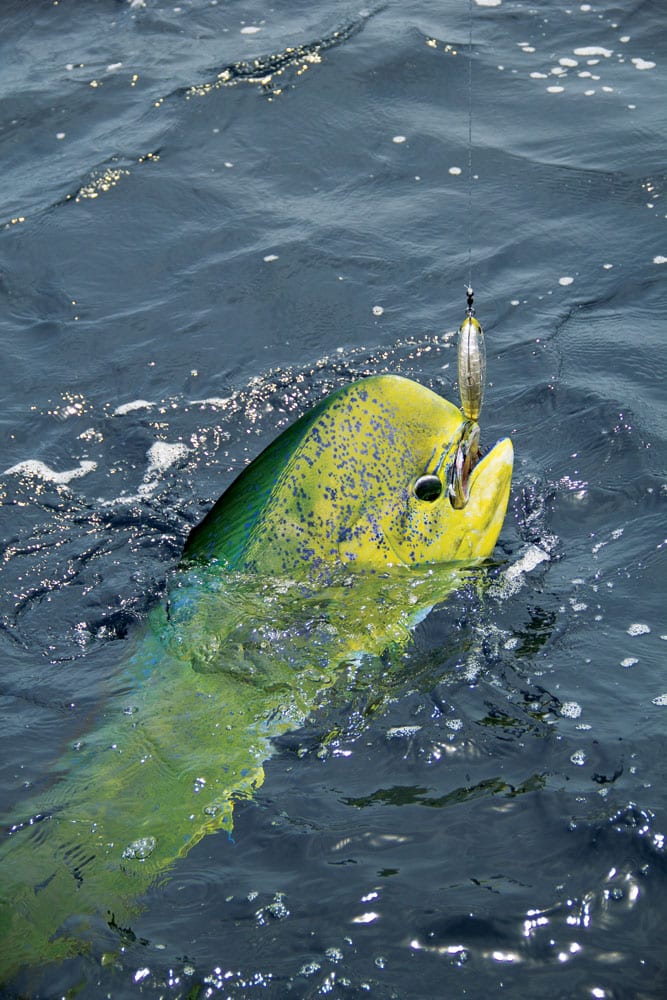
The Pelagic Family
Webster’s defines pelagic as “living or occurring in the open sea or oceans.” Countless species inhabit the world’s seas, yet sport fisheries target just a relative handful, based on factors such as fighting characteristics, size, eating quality, appearance and the desire to take artificial lures.
Strictly speaking, the term “open sea” can be applied to a variety of habitats as well, although we tend to think in terms of deep blue water, perhaps using the standard 100-fathom line as a convenient point of demarcation. The problem is that many pelagic species, such as black marlin and sailfish, are frequently found in green nearshore waters, making geographic boundaries somewhat irrelevant. The fact that islands and reefs containing sedentary species are also found in open offshore waters complicates matters.
Let’s just say that game fish normally associated with oceanic surface habitat make good candidates for some incredible popping and jigging action, with varying degrees of difficulty depending on the species. Billfish, dorados, wahoo, dogtooth tuna and other tunas, giant and bluefin trevallies, narrow-barred mackerel, rainbow runners, yellowtail and skipjacks are all popular pelagic targets.
A variety of techniques and tackle can be effective with pelagics. Obviously, “blind casting” on the open sea is fruitless compared to working a visible habitat, such as a reef point found nearshore. Trolling is the standard method used to find concentrations of fish offshore, as well as for checking out the area for signs of kelp paddies, weed patches, dolphin pods, bird activity, logs and other debris, current lines, temperature breaks, bait schools and man-made attractors such as FADs. Once you find the fish, it’s important to apply techniques that work best on the species you’re targeting.
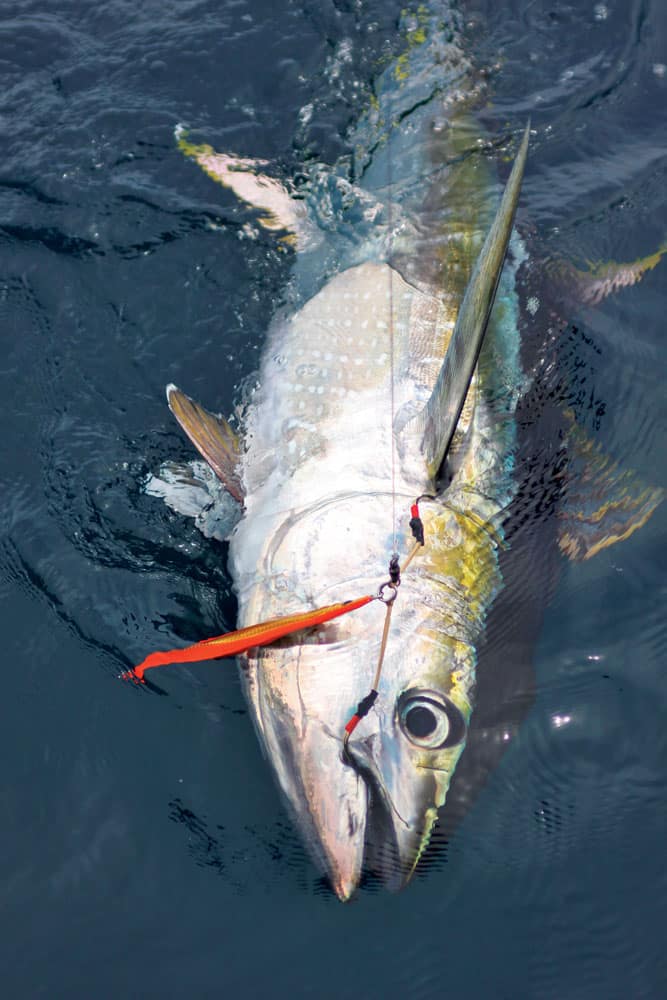
Tuna: The Perfect Pelagic
Of all the pelagics, yellowfin and bluefin tuna score high in terms of size, strength, availability and having a proclivity toward violent strikes on poppers and jigs. Many fishing lodges, in the tropical Eastern Pacific and Gulf of Mexico especially, have geared their boats and tackle for yellowfin over 200 pounds.
On the eastern seaboard, big bluefin provide the main attraction, with fish that exceed 600 pounds sometimes taken on relatively light tackle. Just look at some of the tackle lockers at destinations such as Islas Secas Resort (islassecas.com) and Panama Big Game Fishing Club (panama-sportfishing.com) and you’ll see dozens of high-tech Shimano Stella spinning outfits and a variety of lures to satisfy any angler.
Capt. Carter Andrews, director of fishing at Secas, is a tuna fanatic. His style is different from that of many in competing fleets. While a fast “run ’n’ gun” approach is common in heading off spinner and spotted dolphin to cast for tuna, Andrews prefers to go slower and find smaller “branch” pods that also hold tuna, but are not run over constantly. These pods often produce better hookup ratios. I fished with Andrews last February and witnessed his stealthy approach with good results on yellowfin tuna. On Feb. 24, fishing buddies Paul Howse and Richard Herbst released 25 yellowfin ranging from 40 to 80 pounds in one day, all on poppers. Both Islas Secas Resort and Panama Sport Fishing Lodge have a fleet of 31- to 35-foot center-consoles that can spread several anglers from bow to stern for safe and efficient casting. However, standard flybridge cruisers, such as those found at Cebaco Bay Sportfishing Club, can also be effective when fitted with bow rails and gunwale access. In other words, just about any style of boat can be customized for popping and jigging.
The bluefin fishery differs greatly from tropical yellowfin tactics. Hatteras, Cape Cod, Stellwagen Bank and Prince Edward Island are just a few of the many traditional bluefin tuna grounds. Most fishing tactics include drifting, anchoring or fishing behind draggers with chum. Catching 200- to 600-pound bluefin on light tackle is often aided by relatively shallow water (less than 200 feet deep) and short runs to the fishing grounds at some locations. Contrast that with the 100-mile-plus journeys out of ports in the Gulf of Mexico to locations with more than 1,000 feet of water. The rewards are great, however, with cow yellowfin tuna, wahoo, blackfin tuna, blue marlin, dorados and other pelagics found in good numbers. June to August is a peak period; however, Richard Herbst, of Houston, got on the 85-foot party boat Scat Cat in Port Aransas in February 2013, in between cold fronts, and caught a 105-pound yellowfin on a popper. Typical charters, from center-consoles to party boats, run 30- to 56-hour trips to the “floaters,” or deepwater oil rigs. Herbst’s charter fished the Perdido rig at a 9,000-foot depth, the deepest in the world. Venice, Galveston and Freeport are also good ports to pursue pelagics.
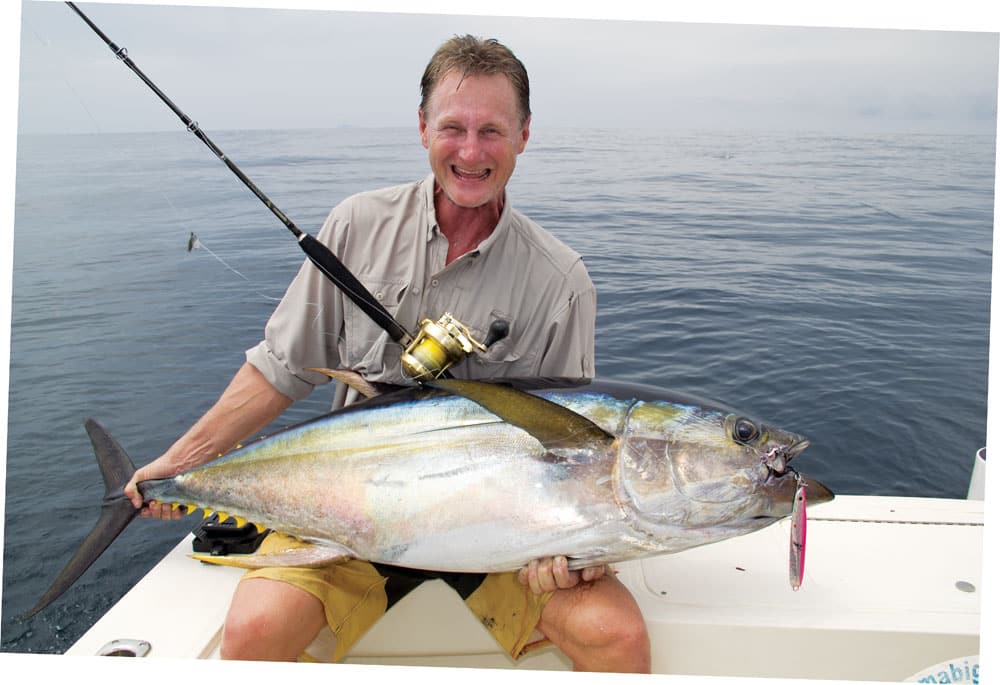
Popper Profile
The class of lures known as poppers, or chuggers, are designed to swim or skip on the surface, and most of them are relatively lightweight and sport concave faces to varying degrees. Some sport narrow profiles, while others come with wide bodies. Popular brands include OTI Komodo, Goanna Wave Dancer and Phantom Wombat; Shimano Orca; JigNPop Heru Skipjack and Tuna; Braid Pop Dancer; and Yo-Zuri GT Bull, Sashimi and Adhek Bali, among others. Most can be fished right out of the box, but to withstand tough saltwater game fish, make sure you select through-wire lures with heavy-gauge hooks, such as the OTI Raptor.
These lures are designed to imitate an injured or escaping baitfish struggling on the surface, which appeals to a wide variety of species throughout temperate and tropical seas. Cool- or cold-water species tend to be more reluctant to chase poppers on the surface.
Traditional poppers are noisy. The concave, or “cupped,” heads trap both air and water on the retrieve, and when whipped forward produce an audible pop, or at least a gurgling sound. Since sound is a big attractant for many game fish, I prefer to make long casts unless aiming for nearby breaking fish or a structure. A long cast improves your results because it provides time for the fish, which may be a good distance away, to hear the pop, react and have a chance of taking the lure before you pull it out of the water.
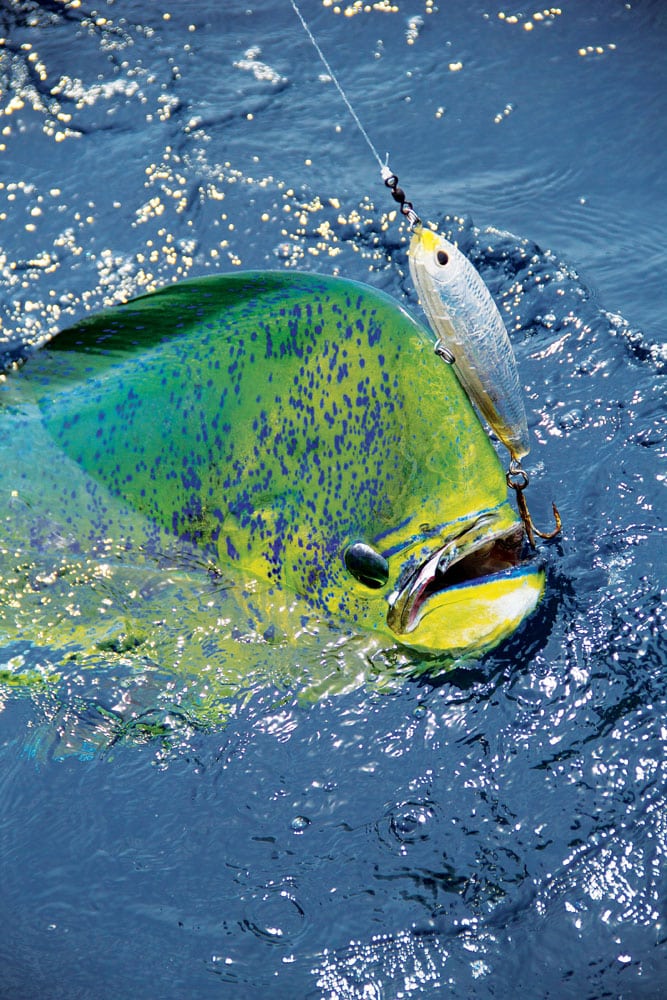
Proper Tackle and Technique
Tackle designed for 40- to 80-pound Spectra line, such as the Shimano TranX, is a good choice for most situations. There is an ongoing revolution in light-tackle level-wind reels, with manufacturers now producing larger sizes, better gearing and tougher, smoother drag systems. When using conventional reels, a level-wind feature is important since these plugs are more efficient and comfortable when worked with one hand cupping the reel seat and side plate of the reel while turning the handle with the other hand. The rod needs to be pumped on the retrieve, which requires a firm grip with all fingers for balance. Guiding line on the reel manually, without a level-wind bar, destroys the balance, distracts the angler’s attention from the lure, and increases the chances of creating loose line wraps on the spool. The shortcomings of non-level-wind reels are magnified when the number of casts increases. It isn’t unusual to make 100 casts or more in a day’s fishing. Any tackle that reduces fatigue increases efficiency and enjoyment.
For lures lighter than 3 ounces, a spinning outfit becomes more practical for casting. Suitable spinning reels include models made by a number of manufacturers; examples include Shimano’s Stella and Saratoga Series and Penn’s Spinfisher V9500, which are capable of exceeding 40 pounds of drag, and hold up to 300 yards of 80-pound Spectra. Similar stiff-action spinning rods are paired with these reels when chasing the big pelagics.
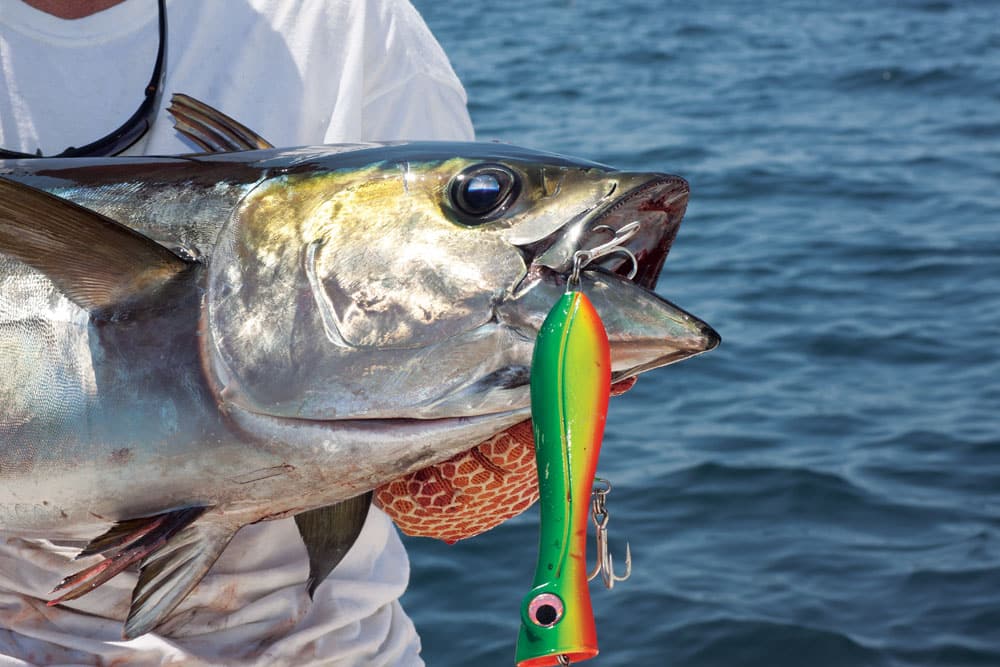
Deep Jigging: Whip It Good
Fish the surface any way you want, but always drop a jig down, whether you have marks on the fish finder or not. It takes extra time and patience, especially when fish aren’t visible, but it adds an important dimension by working the water column for fish that may be surface-shy due to fishing pressure or other reasons in our sometimes crowded spots during the peak summer months. During my last trip to Panama, in March 2013, deep jigging produced nearly as many yellowfin tuna as popping. Deep jigging on the tuna grounds makes sense. According to Shimano, the Butterfly Jigging System was developed in Japan in the early 1990s to catch bluefin tuna in depths of up to 500 feet.
These “slim” jigs have a unique action due to their slightly nonsymmetrical shape and thin profile. They sink like a rocket. The fast sink is a key element in performance since it allows the angler to retrieve it in fast, short intervals. If you had to wait for the jig to flutter down, it would slow the pump technique and destroy the violent action that gets reactive strikes. When retrieved in short strokes, they angle off in horizontal slices rather than vertically. This movement is fooling the bigger, more mature fish that previously would take only a well-presented live bait, in some cases. For the longer jig styles, the presentation differs slightly. Once you hit bottom, or the desired depth, make a long lift, lower the rod to create a slack line on the drop, and then retrieve.
The jigs are designed to work best with a fast-retrieve reel, heavy-duty parabolic rod and Spectra superbraid line. The outfit I use is a Trinidad 20 or Torsa 20 reel filled with 65- to 80-pound PowerPro Spectra tied to six feet of 100-pound P-Line leader and a Trevala TVC 66H rod when fishing 6- to 9-ounce jigs. Of course, lighter tackle can be used when appropriate. Other reels include Jigging Master, Avet HXJ, Accurate 500N, Saltiga 30T, Penn TRQ25N and the Fathom series. For spinning, the Shimano Stella series, Trevala, Black Hole Cape Cod Special and Fathom Blade rods are a good combination.
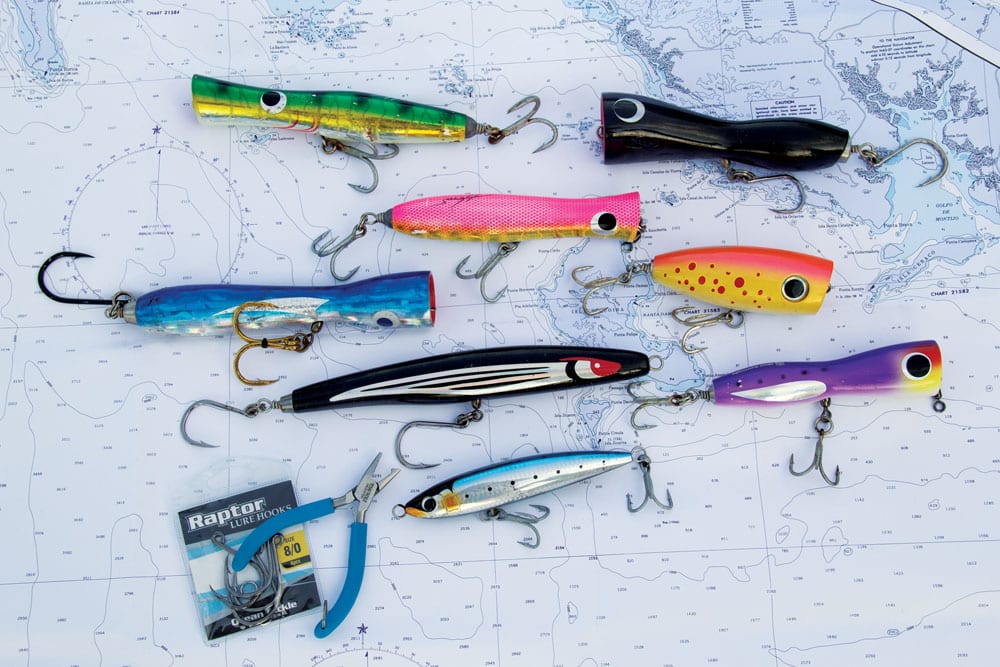
The jigging method is simple and can be learned in minutes, and it is easy enough to work a jig all day without getting worn out. Shimano illustrates this method online at shimano.com, or you can do a Web search for “Shimano Butterfly Jigs.” Just drop the jig to the bottom or desired depth in free-spool (you may get a strike on the fall, so be prepared to engage the drag quickly). As soon as the line goes limp, reel in some line to keep it from snagging on the bottom. Now reel fast for several strokes, stop, swing the rod tip up and then lower as you reel again. Develop a “bouncing rhythm” motion using this fast but short retrieve. The jig will be doing all sorts of sideways and erratic movements that elicit a reactionary strike from a wide variety of game fish.
I call these “upside down” jigs, because the tethered hooks seem to be attached at the wrong end of the lure near the eye with a split ring/solid ring arrangement. One or two hooks may be used. The tethered hooks come with an attached thin cord with a loop on the end that you fasten to the solid ring on the jig.
Tie the leader or main line to the solid ring in between the tethered hooks if you are using two. This takes a little time to get comfortable with, because typically lures are tied on opposite the hook end.
Deep jigging can produce surprising results. For example, after a popping session on a John de la Cruz center-console from Panama Sport Fishing Lodge, we decided to jig for grouper in 400 feet of water, only to hook a 130-pound yellowfin tuna instead. When you’re popping and jigging, you’re covering the water column and its myriad of game-fish possibilities.
